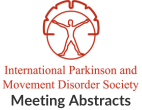Distinct maladaptive and compensatory wiring patterns in penetrant and non-penetrant dystonia mutation carriers
Objective: DYT1 and DYT6 are autosomal dominant mutations for primary dystonia with incomplete penetrance. We have found that expression levels for a distinct dystonia-related functional…Stimulation induced dystypia after pallidal deep brain stimulation
Objective: _ Background: Typing on a keyboard requires complex collaboration between visuospatial procedural memory, language and motor function [1,2]. The impaired ability to type, independent…Catatonia, Parkinsonism and Dystonia in a patient with Osmotic Demyelination Syndrome
Objective: We present a case of Osmotic Demyelination Syndrome (ODS) in a patient who underwent liver transplant and subsequently developed multiple movement disorders. Background: ODS…Clinical and etiological aspects of movement disorders in a low-income country: Case of Mali
Objective: Describing Clinical and etiological aspects of movement disorders in Mali Background: Movement disorders (MD) correspond to a disturbance in the programming and / or…Movement disorders and it association with immunological causes: the key is in the movement
Objective: Observe the clinical and biochemical characteristics and the result of the treatment instituted in movement immune-mediated etiology. Background: Paraneoplastic autoimmune movement disorders are a…Comparison between the results of two multidisciplinary health education program to improve the level of knowledge on key points for the management of motor and non-motor symptoms in people with Parkinson’s disease: a randomized clinical trial
Objective: The objective of this study was to compare the effects of two identical long-term interprofessional programs(in-person classes and by online classes)on the level of…Time matters in brain health: how can health systems respond to the growing demand for genetic testing?
Objective: The global burden of neurodegenerative disease is increasing and health systems are not yet equipped to manage large numbers of people who are at…The Accreditation and Certification of the Movement Disorders Subspecialty: A Five-Year Follow-Up Study
Objective: The purpose of our study was to assess if sentiments regarding the accreditation and certification of Movement Disorders Fellowships have changed over the past…What is holding back apomorphine therapy for Parkinson’s disease? Identifying knowledge gaps amongst Thai neurological medical professionals
Objective: To assess the level of understanding about, and identify knowledge gaps in, apomorphine therapy amongst Thai neurological medical professionals. Background: Continuous subcutaneous apomorphine infusion…Management of Dystonia in Europe from Patients’ Experience
Objective: To investigate management of dystonia in Europe from patients' experience obtained from on-line survey. Background: We have reported a lack of specific training in…
- « Previous Page
- 1
- …
- 770
- 771
- 772
- 773
- 774
- …
- 1554
- Next Page »
